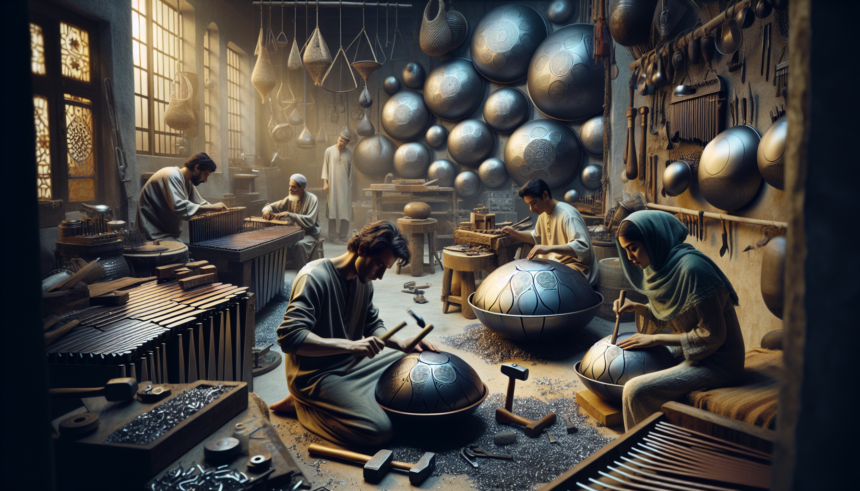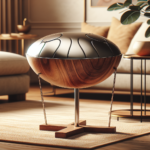The handpan is a relatively recent addition to the world of musical instruments, captivating musicians and listeners alike with its ethereal and soothing tones. The uniqueness of the handpan lies not only in its mesmerizing sound but also in the intricate craftsmanship required to create one. This article delves into the fascinating world of handpan making, exploring its origins, the meticulous crafting process, and its evolution over time.
Origins of the Handpan
While the handpan may seem like a modern creation, its roots can be traced back to the early 2000s. The instrument was developed in Switzerland by Felix Rohner and Sabina Schärer, who were inspired by the steel drum and the hang, a hand-played steel instrument. The desire to create an instrument with a calming and harmonious sound led to the birth of the handpan. The name “handpan” is used to describe a variety of similar instruments that have since been developed, each with its own unique design and sound.
The Crafting Process
The creation of a handpan is a meticulous and intricate process that requires a deep understanding of acoustics, metalworking, and musical theory. Here is a step-by-step breakdown of the crafting process:
- Selecting the Material: The first step in crafting a handpan is selecting the right material. High-quality steel is often used due to its durability and resonance.
- Shaping the Shell: The steel is then shaped into a dome-like shell by hand or using a hydraulic press. The precision in shaping is crucial as it affects the overall sound quality of the instrument.
- Tuning the Notes: The tuned notes are created by hammering specific areas of the shell to different pitches. This step requires an experienced ear and a steady hand to ensure that each note is perfectly in tune.
- Final Assembly: Once the individual notes are tuned, the shells are assembled, and any final adjustments are made. The handpan is then heat-treated to enhance its resonance and durability.
- Finishing Touches: The instrument is polished and often coated with a protective layer to prevent rusting and enhance its appearance. The final step involves retuning and testing the instrument to ensure it meets the highest standards of quality.
Evolution of Handpan Making
Since its inception, the handpan has continued to evolve, with craftsmen experimenting with different materials, designs, and tuning methods to enhance its sound and playability. Here are some key developments in the evolution of handpan making:
Introduction of New Materials
While traditional handpans are made from steel, modern craftsmen have explored using different materials such as stainless steel, brass, and even composite materials. Each material offers unique acoustic properties, contributing to a diverse range of sounds.
Advancements in Tuning Techniques
Early handpans were tuned primarily by hand, which required significant skill and experience. With advancements in technology, craftsmen now use electronic tuning devices to achieve greater precision and consistency in tuning. This has led to the development of handpans with a wider range of scales and tunings.
Customized Designs
The evolution of the handpan has also seen the rise of customized designs. Craftspersons work closely with musicians to create instruments that cater to specific musical styles and preferences. This customization extends to the visual aspects of the handpan as well, with artistic engravings and unique finishes becoming increasingly common.
Hybrid Instruments
The continued innovation in handpan making has given rise to hybrid instruments that combine elements of the handpan with other musical tools. These hybrids offer new possibilities for musicians, allowing them to explore different soundscapes and musical techniques.
Conclusion
The art of handpan making is a testament to the creative ingenuity and dedication of skilled craftsmen. From its humble beginnings in Switzerland to its global popularity, the handpan continues to inspire musicians and listeners with its captivating sound. The ongoing evolution of handpan making ensures that this remarkable instrument will continue to enchant audiences and provide a source of tranquility and harmony for years to come.
FAQs
- What is a handpan?
- A handpan is a musical instrument made from steel, characterized by its dome-shaped shell and soothing, resonant tones. It is played by hand, producing a variety of harmonic sounds.
- How long does it take to make a handpan?
- The time required to make a handpan can vary depending on the experience of the craftsman and the complexity of the design. On average, it can take several weeks to a few months to complete one handpan.
- What materials are used to make a handpan?
- Traditional handpans are made from high-quality steel. However, modern handpans may also use materials like stainless steel, brass, or composite materials to achieve different acoustic properties.
- Can a handpan be tuned to different scales?
- Yes, handpans can be tuned to a wide range of scales and tunings. The choice of scale can be customized based on the preferences of the musician.
- How do I care for my handpan?
- To care for your handpan, regularly clean it with a soft cloth and avoid exposing it to extreme temperatures or humidity. It is also important to store it in a protective case when not in use and periodically check for any signs of rust or damage.





